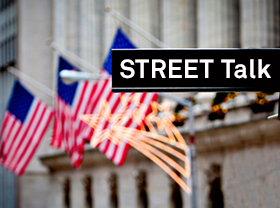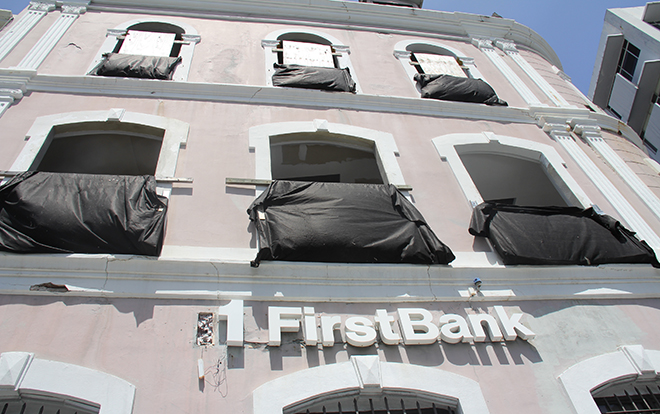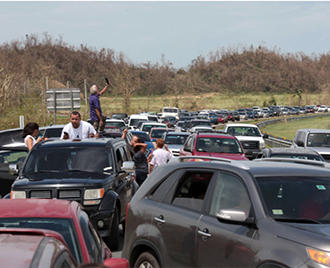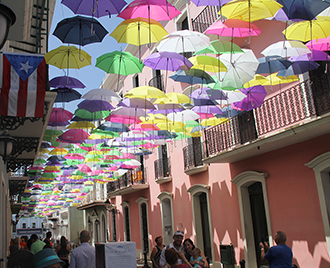After Hurricane Maria tore through Puerto Rico in September 2017, supermarket owner Juan Carlos Agosto Martínez had a different problem than most other residents on the island: "I have close to a million dollars in cash and I don't know where to put that."
Street Talk is a podcast hosted by S&P Global
|
This is what Agosto Martínez recalls telling his account manager at Popular Inc., the largest bank headquartered in Puerto Rico, shortly after the storm hit. Maria left virtually the entire island without power and wiped out communication networks. That left businesses unable to operate point-of-sale systems, which meant no card payments. The island was suddenly dependent on cash. Armored car services on the island also ground to a halt, thanks to communications breakdowns and fuel shortages — leaving Agosto Martínez's grocery stores with a surfeit of cash and no one to pick it up.
"So [my account manager] arranged for the personal driver of the CEO of the bank to [meet us] at one of the stores," Agosto Martínez said in an interview. They loaded the cash into the car and the driver took it to the bank.
"There weren't enough armored cars to take the money to the clients or to pick up the money from the clients," Popular President and CEO Ignacio Alvarez confirmed during an interview at the bank's headquarters in the capital city of San Juan. "We had to do workarounds. We had our private security guards become armored guards."
Juan Carlos Agosto Martínez, the owner of several grocery stores damaged in the hurricane. Source: Lindsey White |
S&P Global Market Intelligence visited Puerto Rico just after the one-year anniversary of Hurricane Maria, one of the most destructive storms in the island's history. Maria caused an estimated $90 billion in damages across Puerto Rico and the U.S. Virgin Islands and led to an estimated 3,000 deaths in Puerto Rico.
In all the reports of catastrophic damage to Puerto Rico's electric grid and telecommunications systems, Maria's impact on the banking industry has been somewhat overlooked. Bankers in Puerto Rico tell stories of abandoning protocols and taking extraordinary steps to keep the lights on and to keep customers and employees afloat.
"My story is the story of many owners. For example I know an owner who had to put the money in the freezer because no one was collecting it,” Agosto Martínez said. "The banking system took forever to come back — forever."
A FirstBank branch in Old San Juan located in a building still showing damage from Maria one year later. The branch is operating, but the bank is moving to a new location. Source: Lindsey White |
Puerto Rico banks closed 8% of branches after Maria
Hurricane Maria laid bare the banking system's dependence on telecommunications systems, and showed how unprepared banks were for the sudden disruption in cell service.
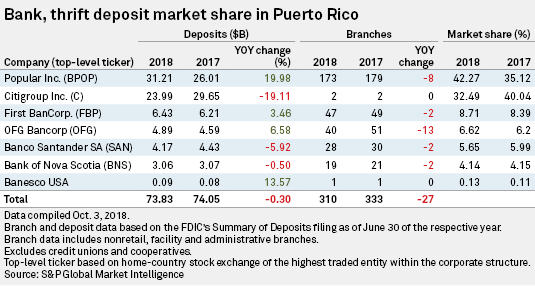 |
"The thing that I think surprised most everybody was the communication failure," Puerto Rico Commissioner of Financial Institutions George Joyner said during an interview in his San Juan offices. "I was here for both Hugo and Georges [massive hurricanes that hit Puerto Rico in 1989 and 1998, respectively]. At that time cellular wasn't such a big component of the telecommunications infrastructure."
And the industry's reliance on cell service is growing, despite the sputtering infrastructure. Banks in Puerto Rico closed at least 27 branches in the year after Hurricane Maria hit — representing roughly 8% of the island’s total branch network, an S&P Global Market Intelligence analysis found.
Some branches closed due to damage. In other cases, banks used the storm as an opportunity to shrink their physical footprint and put more emphasis on mobile offerings.
OFG Bancorp, for example, closed a dozen branches, or about a quarter of its network, following Maria. OFG President and CEO José Rafael Fernández said the hurricane "fit perfectly" into the bank's digital strategy by driving more customers to start adopting technology.
"Maria hit and everybody had to close their branches. There was no electricity, there was no communication, and we had to get branches up to speed as fast as we could. And we did," Fernández said in an interview in San Juan.
"But in the process, customers realized that they had to look for fuel, they had to do other more important things than going to the branch, like going to the supermarket … and all of a sudden they started utilizing mobile more."
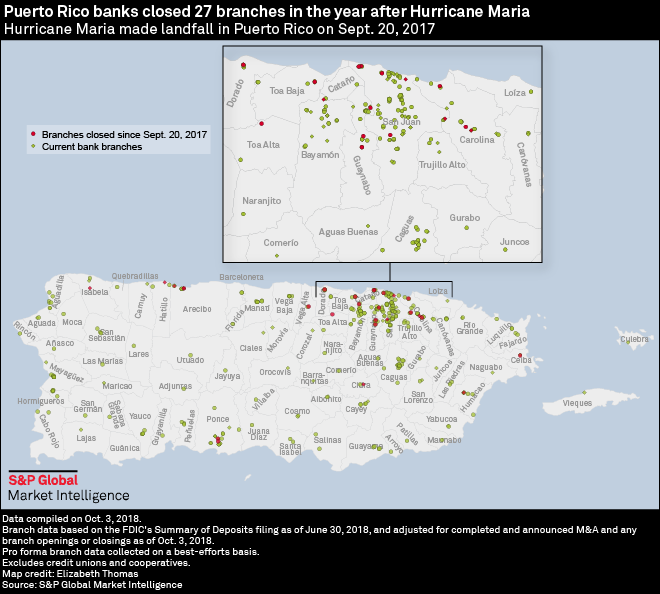
Despite the closures, banks say they remain committed to brick-and-mortar locations in Puerto Rico, where the branch remains a key part of daily life and in-person contact is valued among customers.
"I visited branches in the aftermath of the hurricane early in the morning," Fernández recalls. One day he went to a branch at around 4 a.m. and found a line of 200 people waiting for the bank to open. Another morning in the early hours, he went into a branch to discover something even more surprising — a bank teller blow-drying a customer's hair.
"We had to send an email to all the employees saying, 'Look, blow-drying hair in the branch can break the generator, so please be careful!" he said.
'A desperate time'
Even with working generators, there was no getting around banks' inability to provide critical services.
A traffic jam in Puerto Rico as people search for cell service in Source: Lourdes Aponte Rosario |
Sometimes, the ATMs ran dry, and it was normal to see lines of customers wrapped around the block.
"You could fill those machines up and the money would go like that," Alvarez said, snapping his fingers. "We weren't panicking, but we were concerned that we needed cash."
Many ATMs were not operational.
At Popular, Alvarez described a return to "old-fashioned" banking in the first days after the storm — including hand-written I.O.U.s.
"There were no systems, no nothing. We had a couple of branches where people were really in need of money. And we had to give the instruction that anybody who showed up with a Popular debit card, give them $100 against an I.O.U.," he said.
"At the end of the day I think we lost less than $5,000 on that. People were very honest and we had cases where somebody would say 'I only have $60 in the bank so don't give me $100.' But it was a desperate time. In the aftermath of the storm, cash is king. People needed money."
Banks on the island began holding daily phone calls with U.S. federal banking and credit union regulators, the U.S. Treasury, Homeland Security, the Federal Emergency Management Agency and EVERTEC Inc., the company that manages cash on behalf of the Federal Reserve in Puerto Rico. Puerto Rican banks are subject to the same federal regulations as their mainland counterparts; they are also regulated locally by the Office of the Commissioner of Financial Institutions of Puerto Rico.
A Popular bank branch in San Juan, a year after Hurricane Maria. Source: Lindsey White |
The first order of business was to make sure the island had enough cash, according to Joyner, the island's financial commissioner, who was also on the calls.
"The New York Fed had already pre-positioned about $350 million here in Puerto Rico in the reserve," Joyner said. "After the hurricane struck, they were able to get another $700 million in here within a week. It came in on pallets on one of the relief flights."
Joyner describes these calls as "very open."
"Everybody was talking about their branch networks and what they were doing and how they were going to move cash around," he recalls. "We had the armored car company also involved in the calls. And so it was a lot of different people from a lot of different sectors coming together all cooperating with each other."
A new normal
A year later, bank moratoriums on loan payments have expired, and heading into third-quarter earnings season, Puerto Rican bankers still sound bullish about credit quality. They say business is largely back to normal, despite the visible evidence of the hurricane. Even along San Juan's Milla de Oro — the upscale "Golden Mile" that runs through Puerto Rico's financial district — traffic lights remain out of order, some windows are boarded up and some roofs are covered in tarps.
"If you're looking for things being great, you can find things that look great. If you're looking for things being awful, you can find that too," said Alexander Twerdahl, an analyst at Sandler O'Neill & Partners who covers the Puerto Rican banks.
Two views of Old San Juan, one year after Hurricane Maria hit Puerto Rico. Source: Lindsey White |
There is universal agreement that the banking industry cannot function without a reliable electrical grid and telecommunications network.
What is unclear is the role the banking industry and its regulators will play in addressing that challenge. For now, many bankers shrug when asked what their industry is doing to facilitate telecommunications and electric grid reform.
"Having a good electrical grid is something that's important to us, but we don't advocate how to go about that. We just stay clear of those types of things," Evertec President and CEO Morgan Schuessler Jr. said in an interview.
The industry's reluctance to be a proactive stakeholder in the matter is partly due to the politicized nature of the infrastructure debates on the island, where the government owns utilities like the Puerto Rico Electric Power Authority. PREPA is the sole provider of electricity in Puerto Rico. It is also in the midst of bankruptcy proceedings and negotiating with bondholders to restructure its $9 billion debt.
In June, the Commonwealth’s governor signed a bill allowing the government to partially privatize PREPA — something that the banking and business communities say would be a positive step. As the island receives billions of dollars in federal Maria-related aid, many are optimistic that it could be the stimulus Puerto Rico needs following years of struggle due to a contracting economy, soaring unemployment and poverty levels, and defaults on government debt.
But change is unlikely to come swiftly or easily.
"The reason why we are fiscally and economically where we are today on infrastructure is because for the last 60 years there has not been sufficient private sector leadership to exert change in the island," said OFG Bancorp's Fernández. "And the reason why there has not been private sector leadership is because that private sector for the last 60 years has been in bed with the government, central and municipal. While that continues to exist Puerto Rico will never change for the better. To me, that is what most worries me about the future."




